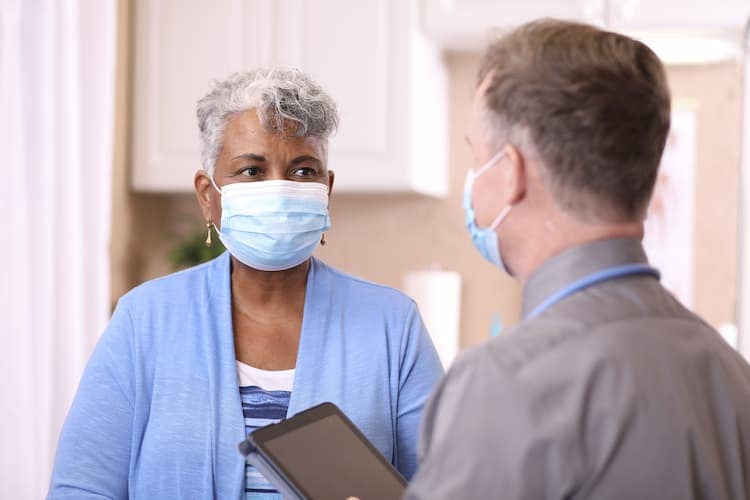Enhancing Clinic Services for Patients

Changing existing policies and practices can give providers time to talk to patients about cancer screening and their cancer risk.
Award recipients in CDC’s National Breast and Cervical Cancer Early Detection Program have found many innovative ways to help those in need of cancer screening get the tests they need. Below, we share highlights from some programs that improved patient services by increasing the amount of time each patient spends with a health care provider, working with a social services call center, and consolidating patient reminders for several types of cancer screening.
Screening Program Helps Low-Cost Health Center in North Dakota Improve Patient Services
Family HealthCare is a primary care clinic that serves all regardless of insurance status and ability to pay. It is the only health clinic for people experiencing homelessness in North Dakota. The North Dakota breast and cervical cancer screening program, Women’s Way, wanted to help Family HealthCare improve their patient services. Women’s Way worked with the health center’s leaders to develop an online assessment of existing policies and practices and interviewed key staff to identify strategies for improvement.
During 2019, Family HealthCare made two changes based on the findings. First, they increased the time for patient visits from 20 to 30 minutes. This gave doctors more time to talk to patients about cancer screening and their cancer risk. The health center also replaced automated patient reminder calls with calls by staff members, so patients could speak with someone before their appointments. These personal interactions created opportunities for staff to solve problems that may have stopped patients from keeping their appointments. As a result, Family HealthCare’s no-show numbers have dropped.
Improved Reminders Lead to More Screening Appointments in Cherokee Nation
In this video, cervical cancer survivor and Cherokee Nation citizen Clara Chewey shares her story.
The Wilma P. Mankiller Health Center is in a very rural area of northeastern Oklahoma. Many women there have low incomes, causing challenges to screening for cancer.
Health center staff worked with the Cherokee Nation breast and cervical cancer screening program to improve their patient reminder system and use it to identify women who needed to be screened. In May 2019, health educators began calling these women to talk about cancer statistics among Native American women, their personal risk for breast and cervical cancer, and any challenges they may be facing that prevented screening. They also helped them schedule and keep their appointments by offering resources to meet those challenges.
As a result, over a 12-month period, 141 women were scheduled for mammograms and 88 women were scheduled for cervical cancer screening tests. In addition, reviewing the patients’ data revealed that more than 400 women who had hysterectomies received reminders to get screened for cervical cancer. Women who have had their cervix removed with a hysterectomy and did not have cancer do not need Pap tests. This error was corrected.
Helpline Navigates South Dakota Women into Screening Program
About one in every four women in South Dakota is not up to date with the recommended screenings for breast and cervical cancer. So, the South Dakota Breast and Cervical Cancer Early Detection Program partnered with the local social services 211 Helpline call center to add a health navigator in their referral system. When their Helpline specialists find out that a caller is not up to date on breast or cervical cancer screening, they ask permission to transfer her to the health navigator. The navigator asks the caller about her medical history, enrolls her in the program if qualified, and refers her to a clinic for cancer screening. Afterward, the navigator makes follow-up calls and schedules appointments.
The health navigator sets monthly goals for the Helpline staff to encourage them to transfer callers. The Helpline center uses their case management software to track referrals, allowing for easier follow-up and reporting.
When Helpline staff can’t reach a client by telephone, they send a text message. The health navigator sends text messages to clients for their first outreach, appointment reminders, and follow-up after their appointments. For example, a woman sent a text message to the Helpline asking for help with her rent. The Helpline specialist referred her to the health navigator, who learned that breast cancer ran in her family; additionally, she had an abnormal Pap test result but had not received follow-up care because she could not afford it. The health navigator helped the woman enroll in the screening program and schedule an appointment for a mammogram and a Pap test.
Between June 1, 2017 and December 31, 2018, 871 women agreed to speak with the health navigator. Of those, 129 were referred to a doctor or scheduled an appointment for cancer screening. Of the 129 women navigated, 57 were enrolled in the screening program. The navigator notes the screening date of each woman so the program can follow up with screening reminders in the future.
Improved Clinic Processes Raise Cancer Screening Numbers in Safety Net Clinics in Maryland
“I am very grateful for the help I received through this program. I thank God for the people who initiated this program that I am sure has been a blessing for many people. Thanks to this program I have been able to get ahead in my cancer process and see my children grow up.”
Ten safety net clinics within Montgomery Cares were having trouble raising their cancer screening numbers. Montgomery Cares is a health care access program for Maryland residents who have low incomes, do not have adequate health insurance, are members of racial and ethnic minority groups, or are immigrants. The patients they serve did not think preventive care and cancer screening was a priority.
The Maryland Breast and Cervical Cancer Program in Montgomery County held focus groups of women who were members of racial and ethnic minority groups to find out why they didn’t get screened for cancer. Patients stated that they found the health care system confusing. The quality improvement manager worked with the clinics to assess current processes and to identify areas for improvement.
Several changes were made in the clinics over time. These changes included holding monthly meetings with clinic staff to share challenges and successes, testing new processes, switching some tasks from doctors to medical assistants, standardizing data entry and tracking, allowing women to get a mammogram immediately after the recommendation during the same visit, called same-day mammography, and focusing on offering more than one type of cancer screening test.
Over the course of 10 years ending in 2019, breast cancer screening rates went up from 29% to 56%, cervical cancer screening rates went up from 7% to 62%, and because they broadened their focus, colorectal cancer screening rates went up from 1% to 49%. A best practice guide was developed and shared with safety net clinics to help them improve cancer screening numbers.
Computer Program Consolidates Colorectal, Breast, and Cervical Cancer Screening Reminders in West Virginia
Between July 2018 and July 2019, the Cabin Creek health system in West Virginia identified the need to save staff time and postage by mailing one reminder to each patient when he or she is due for certain cancer screenings, instead of sending a separate reminder for each cancer screening needed. So, Cabin Creek worked with computer programmers to create a patient registry that lists patients according to their screening needs, with nine possible combinations. For example, a woman who is due for both breast and cervical cancer screening is on a different list than a woman only due for breast cancer screening. The health system also checked the patients’ charts to make sure their screening history and contact information were correct.
After this project was finished, the health system mailed cancer screening reminders to 2,117 patients, asking them to call the clinic to make an appointment. Cabin Creek staff were trained on how and when to update the patient registry. Patients no longer get more than one screening reminder, which was confusing for patients and costly for the health system. Cabin Creek plans to send another round of mailers in six months, and to follow up with telephone calls.
Standard Patient Navigation Process Increases Cancer Screening Numbers in Arizona

Staff help identify issues that a patient is facing that might stop her from getting screened.
Staff at the Mountain Park Health Center in Phoenix, Arizona, needed training on how to navigate patients so that they get breast and cervical cancer screenings. With help from the Well Woman HealthCheck Program, staff at the health center created a detailed process for patient navigation. The standard operating procedures show a patient’s navigation journey from her enrollment in the program through completion of screening and diagnostic follow-up in a way that is easy to understand. The streamlined navigation process provided the foundation for staff training.
Between 2017 and 2018, health center staff used this process to raise its overall breast cancer screening numbers by almost 17% and its cervical cancer screening numbers by about 3%. The health center may use a similar process for patients with other chronic diseases like diabetes.